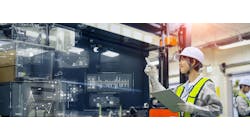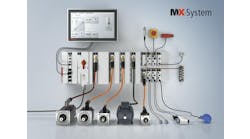It was interesting seeing my article, "Wastewater treatment plants can be built for small-scale applications," featured as part of the cover story in the July 2018 issue of Control Design. In that same issue, I read a Real Answers article,"Select parts and configure systems online," which contained a question from another OEM in the waste-treatment industry asking about using online tools, online stores or portals to make purchasing and receiving parts easier. Several vendors that we use provided answers, but I think they got it all wrong.
I have to tell you, all the solutions the vendors offered were just plain terrible—not one of those vendors has a clue of what it takes its customers to design, specify, order, receive and track purchased components. I say this because after having put together our internal processes, and previously at three other companies, there are clear reasons why we don't order online.
Imagine that, despite all the effort the vendors put into their websites, we don’t use them for online ordering. We may very well be the most efficient small company in the world with the way we build our processing equipment, and none of our vendors help us achieve that with their online ordering.
No progress in online ordering
Of course we order parts online. It's just less than 1% of the time. As director of design and innovation, I am always getting myself in trouble for ordering a couple of parts for a project on my credit card, with no PO, and handing in the paper work later. That makes more work for everyone. Doing this all the time would be catastrophic.
So, here is a real example that highlights how little progress there has been with placing online orders with vendors. Eighteen years ago I was building a machine that had 829 unique parts from more than 60 vendors and manufacturers. A big online vendor was AutomationDirect, who supplied hundreds of electrical parts, and another was McMaster-Carr, who provided many mechanical parts.
I sent McMaster-Carr a PO by email for 259 of the parts. Shortly after, I get a call from McMaster-Carr, and the nice young lady says, “You know you could order these parts online.” My response was, “Yes I know that, and then I would need to type in 259 part numbers. I would also need to select the desired package sizes and enter how many I need for each one of those parts. I would likely make some mistakes, possibly costly ones. By sending a PO, my work is done, and this data entry task has been subcontracted to you, the vendor. Additionally, you’ll gladly take back any mistakes you make at no cost to me.” She sighed and said, “I thought you might say that.”
Things haven't changed; we still need to purchase large numbers of parts. A few days ago AutomationDirect got emailed a PO for about 200 parts and McMaster Carr got emailed a PO for about 150 parts, for another one of those systems featured in the July 2018 cover story of Control Design.
Maybe it would be good to explain our process for built-to-order products that contain more than 500 unique parts that are purchased from about 60 vendors, for just one job. Despite our best efforts and with two vendors supplying about 350 part numbers, we still have many vendors that we need to order from—and we have an internal online system for that.
Parts list by design not online data entry
Our product is completely designed in 3D CAD, and everything is organized by subassemblies in the way that the product gets assembled. This is very important to our company operations. We have a customized bill of material (BOM) in CAD that is saved in an Excel file containing a custom macro. Running the macro combines and totals all the like-sized pieces of pipe and other materials used in the subassembly into single BOM line items for each unique part number. We even handle all the various types of labor as we would a part. The labor can then be handled as an order for our machine shop or assembly area.
The macro formats the BOM for import to a third parts program called AllOrders, which also integrates with our QuickBooks accounting program. Saving the 3D CAD BOM and importing it takes but a minute. At that point, AllOrders can tell us exactly what all the materials cost and gives us a good estimate of the labor cost and hours, too, using the most current data in AllOrders.
The newly created parts list for the job, containing all materials and labor hours, generates a work order for the shop for system assembly labor and work orders for each part that needs to be made in house. It also generates a pick list by subassembly.
The shop quickly goes down the pick list and pulls on-hand parts that were purchased in bulk previously, mostly nuts and bolts, and places them in a subassembly bin. That bin is identified by a label that AllOrders printed that specifies the customer, job number, subassembly number and name. A redlined pick lists goes back to purchasing and anything pulled gets removed or reduced on the planned PO for that vendor. AllOrders then prints the PO to a PDF file and attaches it to an email to the vendor. Much of the parts list details are created automatically from the design and AllOrders.
Attention, vendors, this is what online ordering needs to look like to run an efficient operation, especially when purchasing hundreds of unique parts. Providing online tools to the customer and having them provide the data entry is not the solution. And there is more needed.
Receiving
Once the POs go out, the shop gets a copy of the PO in the form of a receiver for each vendor. This is where some real magic happens. The receiver not only shows how many parts the shop will be getting, it also shows how many of each part goes in the subassembly bin for that job. The only thing that goes to inventory is the remaining parts from orders purchased in bulk. That inventory gets reduced when the pick list calls it out again. We have very little inventory, only enough to cover small changes, errors or damage. Purchasing can then close any PO for which all materials are received.
When parts were placed in bins they were checked off on the drawing BOM, and at that point the BOM and drawings are placed in the bin, indicating it is ready to build. The drawing also has a “Time In, Time Out” bar along the edge.
The time to build the assembly is logged right on the drawing, along with any changes, or notes. The drawing gets returned to engineering so that the changes get made and to revise the labor estimate if needed. I have never found another way to get accurate labor figures except to connect it right to the drawing so the engineer looks at it for revisions, smacks his head and says, “I had no idea it would take that long.”
Sometimes we even send out POs that do not have a cost because we have never purchased that exact part before. Those parts were entered in our system with a cost of $0.01, as POs cannot be generated with a cost of zero. It is amazing how fast the vendors respond to a PO with the correct price when the PO reads, $0.01. We haven’t ever had to call that vendor, the vendor always contacts us. In the meantime, we are moving forward, and POs always get corrections for price and delivery.
Purchase orders are written contracts, too. They spell out our terms for buying from the vendor. They also allow us to give a vendor lots of lead time to fill an order and to tell the vendor that we don’t actually want delivery until a certain date. If the vendor ships sooner, it can expect the order to be refused. It doesn’t happen often, and it never happens twice.
ALSO READ: Select parts and configure systems online

Leaders relevant to this article:




